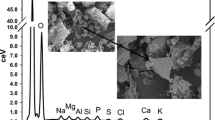Summary
The reproductibility of EUF-Ca, EUF-K, EUF-Na and EUF-P in the different fractions (20°C, 200 V and 80°C, 400 V) as well as the reproducibility of the quantities of maximally desorbable K obtained by EUF and their half-time values are described. The calculations are based on the measurement of 288 individual values (EUF fractions) per nutrient. The following results were obtained:
-
1.
The reproducibility of the EUF-K and EUF-Na contents at 20°C (0–30 min) as well as at 80°C (30–60 min) can be considered as good. The coefficient of variation for the EUF-K contents of all measurements is 3.3%. This value is improved to 2.0% when the sums of the EUF-K values obtained at 20°C and 80°C are combined for all soil samples. The CV for the Na contents of all measurements is 3.3%.
-
2.
The reproducibility of the EUF-Ca contents is better for soils in which desorption processes prevail than for those in which both desorption and dissolution processes of Ca compounds (CaCO3) occur. The CV for the EUF-Ca contents of all measurements is 5.7%.
-
3.
The volumes of anode extracts have a decisive influence on the amounts of P extracted by EUF at constant voltage and temperature. The quantities of P extracted at 20°C and 200 V must, therefore, be corrected with the aid of an equation presented in Fig. 1. The CV of the corrected EUF-P contents of all measurements at 20°C is 7.0%. This value is improved to 2.8% when the sums of the EUF-P values at 20°C and 80°C are combined. The reproducibility of the EUF-P contents at 80°C and 400 V is good. It appears to be unaffected by the extraction volumes. The CV of all P measurements at 80°C, without taking the extraction volumes into account, is 4.3%.
-
4.
The reproducibility of the quantities of maximally desorbable K obtained by EUF and of their half-time values at 80°C and 400 V is very satisfactory. These values are, therefore, suitable for characterizing K reserves in soils.
-
5.
Only small quantities of nutrients are involved in the undesired transport of anions into the cathode extracts and of cations into the anode extracts. To avoid any sources of error, pooling of the anode and cathode extracts before analysis is recommended.
Similar content being viewed by others
References
Grimme H 1979 The use of rate equations for a quantitative description of K desorption from soils in an external electric field (electro-ultrafiltration). Z. Pflanzenernaehr. Bodenk. 142, 57–68.
Németh K 1972 Bodenuntersuchung mittels Elektro-Ultrafiltration (EUF) mit mehrfach variierter Spannung. Landwirtsch. Forsch. Sonderh. 27, 184–196.
Németh K 1976 Die effektive und potentielle Nährstoffverfügbarkeit im Boden und ihre Bestimmung mittels Elektro-Ultrafiltration. Habil. Schrift, Universität Gießen.
Author information
Authors and Affiliations
Rights and permissions
About this article
Cite this article
Németh, K., Recke, H. Reproducibility of Ca, K, Na and P contents in the different EUF fractions. Plant Soil 64, 25–33 (1982). https://doi.org/10.1007/BF02375154
Issue Date:
DOI: https://doi.org/10.1007/BF02375154




